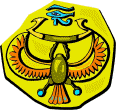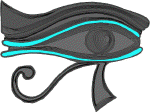

Inside the embalming workshop, a body is lying on a
long, narrow table. Egyptian
priests are carefully preparing it for the tomb.
One priest steps forward with a tray of carved stones, each one engraved
with the name of a god. The stones
are amulets, and they will protect the dead manís soul in its journey to the
Underworld. The priest selects a
beetle-shaped amulet and tucks it securely into the mummyís wrappings, next to
the heart.
Scarabs, the Beetle
Amulets
Other Amulets
How Do We Know That?
The ancient Egyptians believed in the power of lucky charms. They wore amulets, which are pieces of jewelry that protect against evil. When an Egyptian died, amulets were tucked in the layers of wrappings to protect each part of the body. They were buried with mummies for luck and protection in the Afterlife.
Scarabs, the Beetle Amulets
The most popular amulets in ancient Egypt were carved in the shape of
the scarab beetle. To the
Egyptians, the scarab symbolized the sun god Kepri. Kepri was known as the god of creation and rebirth.
Because of this connection, scarabs represented new life.
Scarab amulets were made in many shapes and sizes. They were usually carved from green stones, but could also be made of faience (pottery) or metal. Faience scarabs were usually glazed green. Small, inexpensive scarabs were strung on cords and worn as necklaces. Wealthy or royal Egyptians could afford larger scarabs, which were sometimes made out of bronze, gold or semi-precious gemstones.
When scarabs were used as protective amulets on mummies, they were usually
placed on the chest or throat of the mummy.
Sometimes they were hung around the mummyís neck.
The Egyptians believed that the scarab would protect the soul until it
reached the Afterworld.
Top of Page
Other Amulets
Most ancient Egyptian amulets were made of the same materials as scarabs.
Many amulets were very small, only about an inch long.
They could be carved to  resemble animals, gods or eyes.
Egyptian amulets were usually engraved with prayers or magic spells.
Amulets that bore the names of gods were thought to be the most popular.
resemble animals, gods or eyes.
Egyptian amulets were usually engraved with prayers or magic spells.
Amulets that bore the names of gods were thought to be the most popular.
Top of Page
How Do We Know That?
The tomb of King Tutankhamun is one of the richest ever found.
Scientists who examined the tomb and the mummy within have found King Tut
to be very well protected by amulets. About
143 small amulets were found in King Tutís wrappings.
The King even had a protective facemask, which was engraved with magic
spells. This life size mask was
made of solid gold.
Top of Page
Some images on this page are © 2000-2001 www.arttoday.com.